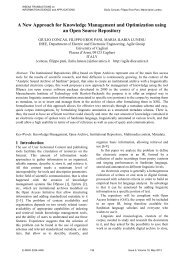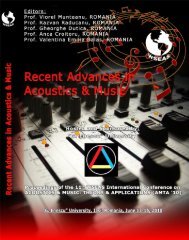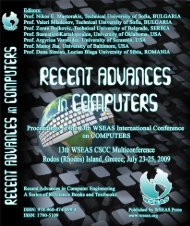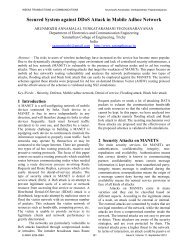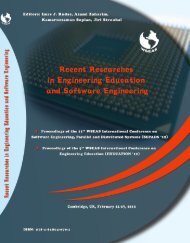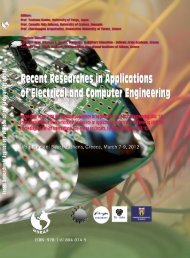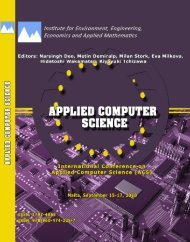Performance of a Modified Cuckoo Search Algorithm for ... - WSEAS
Performance of a Modified Cuckoo Search Algorithm for ... - WSEAS
Performance of a Modified Cuckoo Search Algorithm for ... - WSEAS
You also want an ePaper? Increase the reach of your titles
YUMPU automatically turns print PDFs into web optimized ePapers that Google loves.
<strong>WSEAS</strong> TRANSACTIONS on SYSTEMS Milan Tuba, Milos Subotic, Nadezda Stanarevic<br />
<strong>Per<strong>for</strong>mance</strong> <strong>of</strong> a <strong>Modified</strong> <strong>Cuckoo</strong> <strong>Search</strong> <strong>Algorithm</strong><br />
<strong>for</strong> Unconstrained Optimization Problems<br />
Milan TUBA Milos SUBOTIC Nadezda STANAREVIC<br />
Faculty <strong>of</strong> Computer Science Faculty <strong>of</strong> Computer Science Faculty <strong>of</strong> Mathematics<br />
University Megatrend Belgrade University Megatrend Belgrade University <strong>of</strong> Belgrade<br />
Bulevar umetnosti 29 Bulevar umetnosti 29 Studentski trg 16<br />
SERBIA SERBIA SERBIA<br />
tuba@ieee.org milos.subotic@gmail.com srna@stanarevic.com<br />
Abstract: - <strong>Cuckoo</strong> search (CS) algorithm is one <strong>of</strong> the latest additions to the group <strong>of</strong> nature inspired<br />
optimization heuristics. It has been introduced by Young and Deb in 2009 and was proven to be a promising<br />
tool <strong>for</strong> solving hard optimization problems. This paper presents a modified cuckoo search algorithm <strong>for</strong><br />
unconstrained optimization problems. We implemented a modification where the step size is determined from<br />
the sorted, rather than only permuted fitness matrix. Our modified algorithm was tested on ten standard<br />
benchmark functions. Experimental results show that our modification improves results in most cases,<br />
compared to the pure cuckoo search algorithm.<br />
Key-Words: - <strong>Cuckoo</strong> search, Metaheuristic optimization, Unconstrained optimization, Nature inspired<br />
algorithms<br />
1 Introduction<br />
1Optimization has always been an active research<br />
area since many real-world optimization problems<br />
belong to a class <strong>of</strong> hard problems. In all<br />
optimization problems the goal is to find the<br />
minimum or maximum <strong>of</strong> the objective function.<br />
Thus, unconstrained optimization problems can be<br />
<strong>for</strong>mulated as minimization or maximization <strong>of</strong> Ddimensional<br />
function:<br />
Min (or max) f(x), x=(x1,x2,x3,…xD) (1)<br />
where D is the number <strong>of</strong> variables to be optimized.<br />
Many population based algorithms were<br />
proposed <strong>for</strong> solving unconstrained optimization<br />
problems. Genetic <strong>Algorithm</strong>s (GA), Particle<br />
Swarm Optimization (PSO), and Bee <strong>Algorithm</strong>s<br />
(BA) are among most popular such algorithms. The<br />
success or failure <strong>of</strong> a population based algorithms<br />
depends on its ability to establish proper trade-<strong>of</strong>f<br />
between exploration and exploitation. A poor<br />
balance between exploration and exploitation may<br />
result in a stagnation and premature convergence to<br />
local optima [1], [2].<br />
GA is one <strong>of</strong> the most popular evolutionary<br />
algorithms (EA) in which a population <strong>of</strong><br />
individuals evolves (moves through the fitness<br />
This research is supported by Ministry <strong>of</strong> Science, Republic<br />
<strong>of</strong> Serbia, Project No. III-44006<br />
landscape) according to a set <strong>of</strong> rules such as<br />
selection, crossover and mutation [3], [4], [5],<br />
possibly hybridized with local search [6]. In GA<br />
exploitation is per<strong>for</strong>med by selection operator<br />
where individuals move to the peaks in the fitness<br />
landscape. Exploration is achieved by perturbing<br />
individuals using crossover and mutation operators.<br />
There is also fourth operator, introduced by John<br />
Holland, called inversion which is nowadays rarely<br />
used.<br />
PSO algorithm is another example <strong>of</strong> population<br />
based algorithms [7]. PSO is a stochastic optimization<br />
technique which is well adapted to the<br />
optimization <strong>of</strong> nonlinear functions in multidimensional<br />
space and it has been applied to many<br />
real-world problems [8]. A basic variant <strong>of</strong> the PSO<br />
algorithm operates by having a population (swarm)<br />
<strong>of</strong> candidate solutions (particles). Particles are<br />
moved within the search space according to a simple<br />
equation. The movements <strong>of</strong> the particles are guided<br />
by their own best known position in the search<br />
space as well as the entire swarm’s best known<br />
position.<br />
Ant colony optimization is well established<br />
swarm intelligence metaheuristic based on ant<br />
colony <strong>for</strong>aging behavior. It has been used<br />
successfully <strong>for</strong> different problems [9], [10], [11].<br />
Several metaheuristics have been proposed to<br />
model the specific intelligent behavior <strong>of</strong> honey bee<br />
swarms [12], [13], [14], [15]. The bee swarm<br />
E-ISSN: 2224-2678 62 Issue 2, Volume 11, February 2012
<strong>WSEAS</strong> TRANSACTIONS on SYSTEMS Milan Tuba, Milos Subotic, Nadezda Stanarevic<br />
intelligence was used in the development <strong>of</strong><br />
artificial systems aimed at solving complex<br />
problems in traffic and transportation [13]. That<br />
algorithm is called bee colony optimization<br />
metaheuristic (BCO), which is used <strong>for</strong> solving<br />
deterministic combinatorial problems, as well as<br />
combinatorial problems characterized by<br />
uncertainty. The artificial bee colony (ABC)<br />
algorithm is a relatively new population based metaheuristic<br />
approach based on honey bee swarm [16].<br />
In this algorithm possible solution to the problem is<br />
represented by food source. Quality <strong>of</strong> the solution<br />
is indicated by the amount <strong>of</strong> nectar <strong>of</strong> a particular<br />
food source. Exploitation process is carried by<br />
employed and onlooker bees, while exploration is<br />
done by scouts. There are a number <strong>of</strong><br />
improvements to the ABC algorithm [17], [18],<br />
[19].<br />
A new metaheuristic search algorithm, called<br />
cuckoo search (CS), based on cuckoo bird’s<br />
behavior has been developed by Yang and Deb [20].<br />
It is a very new population based metaheuristic <strong>for</strong><br />
global optimization and only few papers have been<br />
published about it [21], [22]. The original article<br />
does not explain all implementation details, there<br />
are some differences between descriptions in the<br />
original paper and later book by same authors [23].<br />
We wanted to test our understanding <strong>of</strong> the original<br />
algorithm as well as to try to improve it. In this<br />
paper we will introduce our modified version <strong>of</strong> CS<br />
algorithm and validate it against pure version on ten<br />
standard unconstrained test functions. For testing<br />
purposes, we developed our CS s<strong>of</strong>tware named<br />
CSapp on which we implemented both, original and<br />
modified CS algorithm in order to make<br />
comparison.<br />
The rest <strong>of</strong> this paper is organized as follows. In<br />
Section 2, we give a brief introduction to cuckoo<br />
bird’s behavior which is necessary in order to<br />
understand CS algorithm. However, the target topic<br />
<strong>of</strong> Section 2 is detailed description <strong>of</strong> CS algorithm<br />
in both <strong>for</strong>ms: original and modified. Section 3<br />
reports numerical test functions, experimental<br />
settings <strong>of</strong> the algorithm, and experimental analysis<br />
on the proposed approach in comparison with the<br />
original CS algorithm. Finally, Section 4 concludes<br />
this work.<br />
2 <strong>Cuckoo</strong> search algorithm<br />
<strong>Cuckoo</strong> birds attract attention because <strong>of</strong> their<br />
unique aggressive reproduction strategy. <strong>Cuckoo</strong>s<br />
engage brood parasitism. It is a type <strong>of</strong> parasitism in<br />
which a bird (brood parasite) lays and abandons its<br />
eggs in the nest <strong>of</strong> another species. There are three<br />
basic types <strong>of</strong> brood parasitism: intraspecific brood<br />
parasitism, cooperative breeding, and nest takeover<br />
[21]. Some species such as the Ani and Guira<br />
cuckoos lay their eggs in communal nests, though<br />
they may remove others’ eggs to increase the<br />
hatching probability <strong>of</strong> their own eggs [20]. Some<br />
host birds do not behave friendly against intruders<br />
and engage in direct conflict with them. In such<br />
situation host bird will throw those alien eggs away.<br />
In other situations, more friendly hosts will simply<br />
abandon its nest and build a new nest elsewhere.<br />
While flying, some animals and insects follow<br />
the path <strong>of</strong> long trajectories with sudden 90 0 turns<br />
combined with short, random movements. This<br />
random walk is called Lévy flight and it describes<br />
<strong>for</strong>aging patterns in natural systems, such as systems<br />
<strong>of</strong> ants, bees, bumbles, and even zooplanktons.<br />
Mathematical <strong>for</strong>mulation <strong>of</strong> Lévy flight relates to<br />
chaos theory and it is widely used in stochastic<br />
simulations <strong>of</strong> random and pseudo-random<br />
phenomena in nature. These flights can also be<br />
noticed in the movements <strong>of</strong> turbulent fluids. One<br />
example <strong>of</strong> Lévy flight paths is depicted on Fig. 1.<br />
Fig. 1. Possible Lévy flight path<br />
Lévy-style search behavior [24] and random<br />
search in general has been applied to optimization<br />
and implemented in many search algorithms [25],<br />
[26]. One <strong>of</strong> such algorithms is CS [21]. Preliminary<br />
results show its promising capability.<br />
2.1 Description <strong>of</strong> the original CS algorithm<br />
<strong>Cuckoo</strong> <strong>Search</strong> algorithm is population based<br />
stochastic global search metaheuristics. It is based<br />
on the general random walk system which will be<br />
briefly described in this chapter.<br />
E-ISSN: 2224-2678 63 Issue 2, Volume 11, February 2012
<strong>WSEAS</strong> TRANSACTIONS on SYSTEMS Milan Tuba, Milos Subotic, Nadezda Stanarevic<br />
In <strong>Cuckoo</strong> <strong>Search</strong> algorithm, potential solutions<br />
corresponds to <strong>Cuckoo</strong> eggs. Nature systems are<br />
complex and thus, they cannot be modeled by<br />
computer algorithms in its basic <strong>for</strong>m.<br />
Simplification <strong>of</strong> natural systems is necessary <strong>for</strong><br />
successful implementation in computer algorithms.<br />
One approach is to simplify novel <strong>Cuckoo</strong><br />
<strong>Search</strong> algorithm through three below presented<br />
approximation rules:<br />
<strong>Cuckoo</strong>s chose random location (nest) <strong>for</strong><br />
laying their eggs. Artificial cuckoo can lay only<br />
one egg at the time.<br />
Elitist selection process is applied, so only the<br />
eggs with highest quality are passed to the next<br />
generation<br />
Host nests number is not adjustable. Host bird<br />
discovers cuckoo egg with probability pd <br />
[0,1]. If cuckoo egg is disclosed by the host, it<br />
may be thrown away, or the host may abandon<br />
its own nest and commit it to the cuckoo<br />
intruder.<br />
To make the things even simpler, the last<br />
assumption can be approximated by the fraction <strong>of</strong><br />
pd <strong>of</strong> n nests that are replaced by new nests with new<br />
random solutions. Considering maximization problem,<br />
the quality (fitness) <strong>of</strong> a solution can simply<br />
be proportional to the value <strong>of</strong> its objective function.<br />
Other <strong>for</strong>ms <strong>of</strong> fitness can be defined in a similar<br />
way the fitness function is defined in genetic algorithms<br />
and other evolutionary computation algorithms.<br />
A simple representation where one egg in a<br />
nest represents a solution and a cuckoo egg<br />
represents a new solution is used here. The aim is to<br />
use the new and potentially better solutions<br />
(cuckoos) to replace worse solutions that are in the<br />
nests. It is clear that this algorithm can be extended<br />
to the more complicated case where each nest has<br />
multiple eggs representing a set <strong>of</strong> solutions.<br />
A new solution x (t+1) <strong>for</strong> cuckoo i is generated<br />
using a Lévy flight according to the following<br />
equation:<br />
xi (t+1) = xi (t) + α ^ Lévy (λ), (2)<br />
where α (α>0) represents a step scaling size. This<br />
parameter should be related to the scales <strong>of</strong> problem<br />
the algorithm is trying to solve. In most cases, α can<br />
be set to the value <strong>of</strong> 1 or some other constant. The<br />
product ^ represents entry-wise multiplications.<br />
Eq. (2) states that described random walk is a<br />
Markov chain, whose next location depends on two<br />
elements: current location (first term in Eq. 2) and<br />
transition probability (second term in the same<br />
expression).<br />
The random step length is drawn from a Lévy<br />
distribution which has an infinite variance with an<br />
infinite mean:<br />
Lévy ~ u = t -λ (3)<br />
where λ (0,3].<br />
Taking into account basic three rules described<br />
above, pseudo code <strong>for</strong> CS algorithm is:<br />
Start<br />
Objective function f(x), x= (x1,x2…xu) T<br />
Generating initial population <strong>of</strong> n host nests xi<br />
(i=1,2,…n)<br />
While (t Fj) Replace j by the new solution;<br />
Fraction pd <strong>of</strong> worse nests are abandoned and<br />
new nests are being built;<br />
Keep the best solutions or nests with quality<br />
solutions;<br />
Rank the solutions and find the current best<br />
End while<br />
Post process and visualize results<br />
End<br />
2.2 <strong>Modified</strong> cuckoo search algorithm<br />
In the real world, if a cuckoo's egg is very similar to<br />
a host's eggs, then this cuckoo's egg is less likely to<br />
be discovered, thus the fitness should be related to<br />
the difference in solutions. There<strong>for</strong>e, it is a good<br />
idea to do a random walk in a biased way with some<br />
random step sizes.<br />
Both, original, and modified code use random<br />
step sizes. Compared to the original code, we use<br />
different function set <strong>for</strong> calculating this step size.<br />
In the original code, step size is calculated using<br />
following code expression:<br />
r*nests[permute1[i]][j]- nests[permute2 [i]][j] (4)<br />
where r is random number in [0,1] range, nests is<br />
matrix which contains candidate solutions along<br />
with their variables, permute1 and permute2 are<br />
different rows permutation functions applied on<br />
nests matrix.<br />
In order to calculate the step size, instead <strong>of</strong><br />
Equation (4), we used:<br />
r*nests [sorted [i]][j] - nests [permute [i]][j] (5)<br />
The difference is that instead <strong>of</strong> permute1, we<br />
used sorted function. This function sorts nests<br />
E-ISSN: 2224-2678 64 Issue 2, Volume 11, February 2012
<strong>WSEAS</strong> TRANSACTIONS on SYSTEMS Milan Tuba, Milos Subotic, Nadezda Stanarevic<br />
matrix by fitness <strong>of</strong> contained solutions. In this way,<br />
higher fitness solutions have slight advantage over<br />
solutions with lower fitness. This method keeps the<br />
selection pressure (the degree to which highly fit<br />
solutions are selected) towards better solutions and<br />
algorithm should achieve better results. That does<br />
not mean that high fitness solutions will flood<br />
population and the algorithm will become stuck in<br />
local optimum.<br />
CS algorithm detects best solution Xbest at the<br />
beginning <strong>of</strong> each iterative step. Also, at this point<br />
step scale factor is being calculated using Eq. 6:<br />
1<br />
sin / 2<br />
( 1)<br />
/<br />
1 /<br />
2<br />
2<br />
1/<br />
<br />
<br />
<br />
u <br />
2 , <br />
v 1 (6)<br />
<br />
<br />
where β denotes Lévy distribution parameter and
<strong>WSEAS</strong> TRANSACTIONS on SYSTEMS Milan Tuba, Milos Subotic, Nadezda Stanarevic<br />
The global minimum value <strong>for</strong> this function is 0<br />
and the corresponding global optimum solution is<br />
xopt =(x1, x2,…,xn) = (0, 0, . . . , 0).<br />
Figure 1: Surface plot <strong>for</strong> Ackley function<br />
DixonAndPrice is our second test function.<br />
Formulation:<br />
f(x)= + ∑<br />
Global minimum is f5 (x) = 0.<br />
Figure 2: Surface plot <strong>for</strong> Dixon and Price<br />
function<br />
Griewank is third test function. Formulation:<br />
f(x) = ∑<br />
∏<br />
X is in the interval <strong>of</strong> [-600, 600]. The global<br />
minimum value <strong>for</strong> this function is 0 and the<br />
corresponding global optimum solution is xopt =(x1,<br />
x2, . . . , xn) = (100, 100, . . . , 100). Since the<br />
number <strong>of</strong> local optima increases with the<br />
dimensionality, this function is strongly multimodal.<br />
The multimodality disappears <strong>for</strong> sufficiently high<br />
dimensionalities (n > 30) and the problem seems<br />
unimodal.<br />
√<br />
2<br />
Figure 3: Surface plot <strong>for</strong> Griewank function<br />
Penalized function is difficult <strong>for</strong> optimization<br />
because <strong>of</strong> its combinations <strong>of</strong> different periods <strong>of</strong><br />
the sine function. Formulation:<br />
2<br />
2<br />
x <br />
10sin<br />
( yi<br />
) ( yn<br />
1)<br />
<br />
f ( x)<br />
n1<br />
2<br />
2<br />
n <br />
( y 1)<br />
[ 1<br />
10sin<br />
(<br />
i1<br />
i<br />
yi<br />
<br />
n<br />
i1 ( x u<br />
yi = 1 +<br />
i<br />
, 10,<br />
100,<br />
4)<br />
(xi + 1)<br />
m k(<br />
xi<br />
a)<br />
, xi<br />
a,<br />
<br />
u(<br />
xi<br />
, a,<br />
k,<br />
m)<br />
0,<br />
a<br />
xi<br />
a<br />
<br />
m<br />
k(<br />
xi<br />
a)<br />
, xi<br />
a<br />
1<br />
<br />
<br />
<br />
)] <br />
The global minimum value <strong>for</strong> this function is 0<br />
and the corresponding global optimum solution is<br />
xopt =(x1, x2, . . . , xn-1, xn) = (-1, -1, . . . , -1, -5). X<br />
is in the interval <strong>of</strong> [-32, 32].<br />
Figure 4: Surface plot <strong>for</strong> penalized function<br />
Rastrigin function is based on Sphere function<br />
with the addition <strong>of</strong> cosine modulation to produce<br />
many local minima. Formulation:<br />
E-ISSN: 2224-2678 66 Issue 2, Volume 11, February 2012
<strong>WSEAS</strong> TRANSACTIONS on SYSTEMS Milan Tuba, Milos Subotic, Nadezda Stanarevic<br />
f(x) = 10n + ∑<br />
The global minimum value <strong>for</strong> this function is 0<br />
and the corresponding global optimum solution is<br />
xopt =(x1, x2, . . . , xn) = (0, 0, . . . , 0). X is in the<br />
interval <strong>of</strong> [-5.12, 5.12].<br />
Figure 5: Surface plot <strong>for</strong> Rastrigin function<br />
Schwefel function as our sixth benchmark.<br />
Formulation:<br />
f(x) = ∑ √<br />
This function has a value - 418.9828 and at its<br />
global minimum (420.9867, 420.9867,…,<br />
420.9867). Schwefel’s function is deceptive in that<br />
the global minimum is geometrically distant, over<br />
the variable space, from the next best local minima.<br />
There<strong>for</strong>e, the search algorithms are potentially<br />
prone to convergence in the wrong direction. Test<br />
area is usually restricted to hypercube – 500 ≤ xi ≤<br />
500, i = 1, . . . , n.<br />
Figure 6: Surface plot <strong>for</strong> Schwefel function<br />
Sphere function that is continuous, convex and<br />
unimodal. Formulation:<br />
f(x)=∑<br />
Global minimum value <strong>for</strong> this function is 0 and<br />
optimum solution is xopt =(x1, x2,…,xn) = (0, 0, .. , 0).<br />
x is in the interval <strong>of</strong> [-100, 100].<br />
Figure 7: Surface plot <strong>for</strong> Sphere function<br />
Step is our eighth benchmark function.<br />
Formulation:<br />
f(x) = ∑<br />
This function represents the problem <strong>of</strong> flat<br />
surfaces. It is very hard <strong>for</strong> algorithms without<br />
variable step sizes to conquer flat surfaces problems<br />
because there is no in<strong>for</strong>mation about which<br />
direction can provide optimal solution.<br />
Figure 8: Surface plot <strong>for</strong> Step function<br />
Ninth function used <strong>for</strong> tests is Perm function.<br />
Formulation:<br />
n<br />
<br />
n<br />
k<br />
k<br />
(<br />
<br />
k<br />
<br />
i 0.<br />
5)(<br />
( xi<br />
/ ) 1<br />
1 i1<br />
<br />
f ( x)<br />
<br />
i )<br />
The global minimum <strong>of</strong> Perm function is 0and<br />
corresponding optimal solution is xopt = (x1, x2, . . .<br />
xn) = (1, 2,…, n).<br />
E-ISSN: 2224-2678 67 Issue 2, Volume 11, February 2012<br />
2
<strong>WSEAS</strong> TRANSACTIONS on SYSTEMS Milan Tuba, Milos Subotic, Nadezda Stanarevic<br />
Figure 9: Surface plot <strong>for</strong> Perm function<br />
Our last test function is Zakharov function.<br />
Formulation:<br />
2<br />
4<br />
n n<br />
n<br />
2<br />
f ( x)<br />
x (<br />
0.<br />
5i<br />
xi)<br />
<br />
i<br />
( i1<br />
0.<br />
5i<br />
xi)<br />
i1<br />
i1<br />
i1<br />
Zakharov function has a global minimum <strong>of</strong> 0 <strong>for</strong><br />
xopt = (x1, x2, . . . xn) = (0, 0,…, 0).<br />
Figure 10: Surface plot <strong>for</strong> Zakharov function<br />
Summary <strong>of</strong> above mentioned benchmarks is<br />
given in Table 1. Variable range and <strong>for</strong>mulation is<br />
shown <strong>for</strong> the each test function. Optimum <strong>for</strong> all<br />
functions is at (0, …, 0).<br />
3.2 Experimental results and algorithm’s<br />
settings<br />
We tried to vary the number <strong>of</strong> host nests<br />
(population size n) and the probability <strong>of</strong> discovery<br />
pd. We have used different settings <strong>for</strong> n (5, 10, 15,<br />
20, 50, 100, 150, 250, 500) and <strong>for</strong> pd. (0, 0.01, 0.05,<br />
0.1, 0.15, 0.2, 0.25, 0.4, 0.5) . From test phase<br />
simulations, we found that n = 25 and pd = 0.25 are<br />
sufficient <strong>for</strong> most optimization problems. This<br />
means that the fine parameters tuning are not needed<br />
<strong>for</strong> any given problem. There<strong>for</strong>e, we used fixed<br />
n = 25 and pd = 0.25 <strong>for</strong> all given problems.<br />
Function Range Formulation<br />
Ackley<br />
[-32,32] n<br />
DixAndPr [-10,10] n<br />
Griewank<br />
Penalized [-50,50] n<br />
Rastrigin<br />
Schwefel<br />
Sphere<br />
Step<br />
Perm<br />
Zakharov<br />
- 20exp( √<br />
(<br />
∑<br />
[-<br />
n ∑<br />
600,600]<br />
[-<br />
5.12,5.12] n<br />
[-<br />
500,500] n<br />
[-<br />
100,100] n<br />
[-<br />
100,100] n<br />
+ ∑<br />
∑<br />
)<br />
∏<br />
) – exp<br />
2<br />
2<br />
x <br />
10sin<br />
( y <br />
<br />
i)<br />
( yn<br />
1)<br />
f ( x)<br />
n1<br />
<br />
2<br />
2<br />
n <br />
( y 1)<br />
[ 1 10sin<br />
(<br />
<br />
1)]<br />
i 1 i<br />
yi<br />
<br />
<br />
n<br />
i1 y i = 1 +<br />
( , 10,<br />
100,<br />
4)<br />
x u<br />
i<br />
(x i + 1)<br />
m k(<br />
xi<br />
a)<br />
, xi<br />
a,<br />
<br />
u(<br />
xi<br />
, a,<br />
k,<br />
m)<br />
0,<br />
a<br />
xi<br />
a<br />
<br />
m<br />
k(<br />
xi<br />
a)<br />
, xi<br />
a<br />
10n + ∑<br />
∑ √<br />
∑<br />
∑<br />
[-<br />
100,100] n n<br />
<br />
n<br />
k<br />
f ( x)<br />
<br />
k<br />
(<br />
<br />
k<br />
<br />
i 0.<br />
5)(<br />
( xi<br />
/ i)<br />
1)<br />
1 i1<br />
<br />
[-<br />
100,100] n<br />
f ( x)<br />
n<br />
<br />
i1<br />
√<br />
n<br />
n<br />
x i i<br />
i1<br />
i1<br />
2<br />
(<br />
i 0.<br />
5i<br />
x ) (<br />
i1<br />
Table 1: Benchmark functions summary<br />
2<br />
2<br />
2<br />
4<br />
0.<br />
5i<br />
x )<br />
We tested each benchmark function six times<br />
with 5, 10, 50, 100, 500 and 1000 variables. Thus,<br />
we conducted totally 48 tests (8 functions * 6<br />
variable numbers). For every test, we carried on 30<br />
runs with 500 cycles per each run. We printed out<br />
best, worst and mean results as well the standard<br />
deviation within the set <strong>of</strong> 30 runs. Parameter<br />
settings are in Table 2.<br />
Parameter Value<br />
Runtime 30<br />
Max Cycle 500<br />
n 25<br />
D 5/10/50/100/500/1000<br />
0.25<br />
pd<br />
Table 2: Parameter settings <strong>for</strong> benchmark<br />
functions.<br />
E-ISSN: 2224-2678 68 Issue 2, Volume 11, February 2012
<strong>WSEAS</strong> TRANSACTIONS on SYSTEMS Milan Tuba, Milos Subotic, Nadezda Stanarevic<br />
Tests were done on Intel Core2Duo T8300<br />
mobile processor with 4GB <strong>of</strong> RAM on Windows 7<br />
x64 Ultimate Operating System and NetBeans 6.9.1<br />
IDE (Integrated Development Environment).<br />
Experimental results with 5, 10, 50, 100, 500 and<br />
1000 variables are shown in Tables 3, 4, 5, 6, 7 and<br />
8 respectively. All tables have two columns with<br />
results in order to make side by side comparison. In<br />
the first column, we show results <strong>of</strong> original, and in<br />
the second, results <strong>of</strong> modified algorithm. We<br />
showed values <strong>for</strong> best, mean, worst and standard<br />
deviation.<br />
Function Original <strong>Modified</strong><br />
Best<br />
Mean<br />
Ackley<br />
Worst<br />
SD<br />
Best<br />
DixonAndPrice Mean<br />
Worst<br />
SD<br />
Best<br />
Griewank Mean<br />
Worst<br />
SD<br />
Best<br />
Penalized Mean<br />
Worst<br />
SD<br />
Best<br />
Rastrigin Mean<br />
Worst<br />
SD<br />
Best<br />
Mean<br />
Schwefel<br />
Worst<br />
SD<br />
Best<br />
Sphere Mean<br />
Worst<br />
SD<br />
Best<br />
Step Mean<br />
Worst<br />
SD<br />
Perm Best<br />
Mean<br />
Worst<br />
SD<br />
Zakharov Best<br />
Mean<br />
Worst<br />
SD<br />
1.17E-12<br />
8.52E-11<br />
1.24E-09<br />
2.23E-10<br />
3.40E-1<br />
0.057<br />
0.123<br />
0.097<br />
1.32E-28<br />
6.72E-26<br />
1.65E-23<br />
3.26E-24<br />
1.29E-6<br />
2.04E-5<br />
9.77E-5<br />
2.17E-5<br />
3.33E-22<br />
1.77E-18<br />
5.32E-16<br />
9.56E-16<br />
0.391<br />
134.333<br />
152.219<br />
68.546<br />
5.25E-26<br />
2.50E-22<br />
3.75E-21<br />
7.88E-22<br />
3.87E-6<br />
3.57E-5<br />
4.56E-4<br />
4.60E-5<br />
1.34E-3<br />
2.89E-3<br />
3.01E-3<br />
4.34E-4<br />
1.02E-1<br />
1.37E-1<br />
1.63E-1<br />
1.32E-1<br />
3.05E-13<br />
0.01E-11<br />
9.52E-10<br />
1.12E-10<br />
2.32E-2<br />
0.008<br />
0.035<br />
0.012<br />
5.66E-29<br />
9.05E-27<br />
5.97E-24<br />
9.31E-25<br />
5.49E-7<br />
1.12E-5<br />
5.69E-5<br />
0.11E-5<br />
1.03E-23<br />
3.52E-19<br />
8.71E-17<br />
5.52E-18<br />
0.352<br />
125.886<br />
138.137<br />
56.002<br />
4.63E-28<br />
8.45E-24<br />
7.34E-22<br />
4.23E-23<br />
1.23E-6<br />
1.44E-5<br />
1.002E-4<br />
1.05E-5<br />
6.20E-4<br />
1.46E-3<br />
1.76E-3<br />
7.73E-4<br />
3.78E-2<br />
4.21E-2<br />
5.98E-2<br />
1.58E-2<br />
Table 3: Experimental results <strong>for</strong> 5 variables<br />
Reported numbers are objective function values,<br />
solution vectors are not <strong>of</strong> particular interest since<br />
there are no constraints in these benchmark<br />
functions.<br />
As we can see from the Table 3, modified CS<br />
algorithm has outper<strong>for</strong>med the original algorithm<br />
in all eight benchmark functions in tests with 5<br />
variables. Best values <strong>for</strong> almost all test functions<br />
are better by factor <strong>of</strong> 10 -1 . Difference in mean<br />
values is less pronounced. Results <strong>for</strong> Sphere<br />
benchmark showed slightly higher difference, where<br />
modified CS outscored the original by factor <strong>of</strong> 10 -2 .<br />
Function Original <strong>Modified</strong><br />
Best<br />
Mean<br />
Ackley<br />
Worst<br />
SD<br />
Best<br />
DixonAndPrice Mean<br />
Worst<br />
SD<br />
Best<br />
Griewank Mean<br />
Worst<br />
SD<br />
Best<br />
Penalized Mean<br />
Worst<br />
SD<br />
Best<br />
Rastrigin Mean<br />
Worst<br />
SD<br />
Best<br />
Schwefel Mean<br />
Worst<br />
SD<br />
Best<br />
Sphere Mean<br />
Worst<br />
SD<br />
Best<br />
Step Mean<br />
Worst<br />
SD<br />
Perm Best<br />
Mean<br />
Worst<br />
SD<br />
Zakharov Best<br />
Mean<br />
Worst<br />
SD<br />
1.65E-7<br />
1.10E-6<br />
3.85E-6<br />
9.30E-7<br />
0.593<br />
0.664<br />
0.703<br />
0.013<br />
9.18E-18<br />
5.03E-15<br />
4.82E-14<br />
9.89E-15<br />
3.20E-4<br />
2.19E-4<br />
1.01E-3<br />
9.93E-3<br />
1.77E-15<br />
4.72E-09<br />
4.54E-08<br />
1.16E-08<br />
661.309<br />
883.518<br />
903.102<br />
124.294<br />
4.29E-15<br />
6.04E-13<br />
5.12E-12<br />
9.66E-13<br />
8.12E-5<br />
3.33E-4<br />
2.52E-3<br />
7.66E-4<br />
5.03E-2<br />
7.12E-2<br />
8.64E-2<br />
5.20E-3<br />
4.77E-1<br />
5.41E-1<br />
6.56E-1<br />
1.87E-1<br />
3.56E-8<br />
9.13E-7<br />
0.09E-6<br />
0.05E-8<br />
0.455<br />
0.602<br />
0.679<br />
0.004<br />
5.67E-19<br />
7.56E-16<br />
9.75E-15<br />
8.92E-16<br />
8.45E-4<br />
1.22E-3<br />
4.32E-2<br />
1.02E-2<br />
5.03E-17<br />
8.51E-11<br />
8.13E-9<br />
5.81E-10<br />
628.205<br />
862.334<br />
891.367<br />
102.004<br />
1.09E-16<br />
2.32E-14<br />
4.56E-13<br />
4.29E-14<br />
1.05E-5<br />
1.23E-4<br />
0.05E-3<br />
2.52E-4<br />
1.06E-2<br />
6.37E-2<br />
8.02E-2<br />
4.60E-3<br />
3.34E-1<br />
4.26E-1<br />
5.34E-1<br />
1.78E-1<br />
Table 4: Experimental results <strong>for</strong> 10 variables<br />
E-ISSN: 2224-2678 69 Issue 2, Volume 11, February 2012
<strong>WSEAS</strong> TRANSACTIONS on SYSTEMS Milan Tuba, Milos Subotic, Nadezda Stanarevic<br />
Both algorithms achieved downward results in<br />
Schwefel function tests, where best results <strong>for</strong> both<br />
algorithms reached are far away from Schwefel`s<br />
real optimum (0.391 (original) compared to 0.352<br />
(modified)). This can be explained with deceptive<br />
nature <strong>of</strong> Schwefel function whose global minimum<br />
is geometrically distant over the variables space<br />
from the next best local minima. Deceptiveness<br />
protracts optimization and algorithms converge in<br />
the wrong direction (see Section 3.1).<br />
Function Original <strong>Modified</strong><br />
Best<br />
Mean<br />
Ackley<br />
Worst<br />
SD<br />
Best<br />
DixonAndPrice Mean<br />
Worst<br />
SD<br />
Best<br />
Griewank Mean<br />
Worst<br />
SD<br />
Best<br />
Penalized Mean<br />
Worst<br />
SD<br />
Best<br />
Rastrigin Mean<br />
Worst<br />
SD<br />
Best<br />
Schwefel Mean<br />
Worst<br />
SD<br />
Best<br />
Sphere Mean<br />
Worst<br />
SD<br />
Best<br />
Step Mean<br />
Worst<br />
SD<br />
Perm Best<br />
Mean<br />
Worst<br />
SD<br />
Zakharov Best<br />
Mean<br />
Worst<br />
SD<br />
3.91E-5<br />
5.39E-4<br />
1.25E-3<br />
4.19E-4<br />
0.667<br />
0.674<br />
0.692<br />
0.022<br />
1.58E-9<br />
1.60E-8<br />
1.10E-7<br />
2.50E-8<br />
0.115<br />
0.206<br />
0.295<br />
0.039<br />
8.53E-8<br />
8.01E-6<br />
5.48E-5<br />
1.23E-5<br />
9781.549<br />
10813.984<br />
10905.389<br />
361.787<br />
2.36E-8<br />
4.64E-6<br />
4.28E-5<br />
8.43E-6<br />
3.392<br />
4.141<br />
4.308<br />
0.532<br />
3.38E-1<br />
4.16E-1<br />
5.45E-1<br />
1.41E-1<br />
5.441<br />
7.372<br />
8.231<br />
2.817<br />
0.72E-5<br />
3.21E-4<br />
0.05E-3<br />
2.09E-4<br />
0.625<br />
0.661<br />
0.685<br />
0.015<br />
9.92E-10<br />
0.41E-8<br />
9.92E-8<br />
1.02E-8<br />
0.193<br />
0.288<br />
0.322<br />
0.076<br />
2.39E-14<br />
2.39E-10<br />
8.13E-8<br />
0.03E-7<br />
9653.209<br />
10012.562<br />
10652.001<br />
307.905<br />
3.02E-10<br />
9.45E-8<br />
3.89E-6<br />
9.49E-8<br />
3.013<br />
3.994<br />
4.215<br />
0.486<br />
2.24E-1<br />
3.74E-1<br />
4.98E-1<br />
1.28E-1<br />
3.767<br />
6.662<br />
7.567<br />
1.705<br />
Table 5: Experimental results <strong>for</strong> 50 variables<br />
If we compare test results with 5 and 10<br />
variables (see Tables 3 and 4), we can observe that<br />
the per<strong>for</strong>mance is much worse in tests with 10<br />
variables in the original, as well in the modified CS<br />
algorithm.<br />
It is also interesting to notice that the original CS<br />
algorithm outper<strong>for</strong>med modified CS in Penalized<br />
test. It was not the case in 5 variables test. For other<br />
benchmarks, modified CS still per<strong>for</strong>ms better than<br />
the original.<br />
Now, if we contrast results <strong>for</strong> 10 variables with<br />
50 variables (see Tables 4 and 5), only minor<br />
per<strong>for</strong>mance impact can be noticed in higher<br />
number <strong>of</strong> variables test. Exceptions are Sphere,<br />
Rastrigin and Griewank functions. For example,<br />
best value <strong>for</strong> Sphere <strong>of</strong> modified algorithm is<br />
1.09*10 -16 in 10 parameter test, while the same<br />
value <strong>for</strong> 50 parameter test is 3.02*10 -10 .<br />
<strong>Per<strong>for</strong>mance</strong> difference <strong>of</strong> 10 6 in favor <strong>of</strong> 10<br />
parameter test is significant.<br />
In Rastrigin test, difference in best value is also<br />
significant (10 -3 ), while mean value comparison<br />
shows just slightly per<strong>for</strong>mance variation (10 -1 ).<br />
The greatest dissimilarity shows Griewank test.<br />
If we compare modified algorithms` results, we can<br />
notice that in 10 parameter tests, per<strong>for</strong>mance <strong>for</strong><br />
best, mean and worst values are better by<br />
approximately the factor <strong>of</strong> 10 8 than results in 50<br />
variables test.<br />
Overall, in 50 parameter test, modified CS shows<br />
better per<strong>for</strong>mance than the original <strong>for</strong> all<br />
benchmarks except <strong>for</strong> Penalized functions in all -<br />
best, worst, mean and standard deviation indicators.<br />
This noteworthy superiority <strong>of</strong> modified CS<br />
algorithm cannot be neglected.<br />
Experimental results in 100 parameter test are<br />
shown in Table 6, which is listed below. As we can<br />
see from Table 6, in 100 variables test, per<strong>for</strong>mance<br />
is further downgraded. Schwefel function shows<br />
results which are higher than 24 thousand. Penalized<br />
function values are slightly above 0, but still better<br />
in the original than in the modified CS algorithm.<br />
Only, Ackley, Griewank, Sphere and Rastrigin<br />
benchmarks achieved results which are close to 0.<br />
Step function best value is <strong>for</strong> example far from<br />
optimum, in both, original and modified algorithm<br />
(12.905 and 12.302, respectively).<br />
Like in previous test, modified algorithm shows<br />
better per<strong>for</strong>mance than the original. The only<br />
exception is Penalized function.<br />
In 500 variables test, Table 7, best values <strong>for</strong><br />
Griewank, Rastrigin and Sphere functions only<br />
reach results close to 0. Also, modified CS obtained<br />
best Ackley`s result which is near to 0 (6.78*10 -1 ).<br />
E-ISSN: 2224-2678 70 Issue 2, Volume 11, February 2012
<strong>WSEAS</strong> TRANSACTIONS on SYSTEMS Milan Tuba, Milos Subotic, Nadezda Stanarevic<br />
Function Original <strong>Modified</strong><br />
Best<br />
Mean<br />
Ackley<br />
Worst<br />
SD<br />
Best<br />
DixonAndPrice Mean<br />
Worst<br />
SD<br />
Best<br />
Griewank Mean<br />
Worst<br />
SD<br />
Best<br />
Penalized Mean<br />
Worst<br />
SD<br />
Best<br />
Rastrigin Mean<br />
Worst<br />
SD<br />
Best<br />
Schwefel Mean<br />
Worst<br />
SD<br />
Best<br />
Sphere Mean<br />
Worst<br />
SD<br />
Best<br />
Step Mean<br />
Worst<br />
SD<br />
Perm Best<br />
Mean<br />
Worst<br />
SD<br />
Zakharov Best<br />
Mean<br />
Worst<br />
SD<br />
1.93E-4<br />
0.002<br />
0.003<br />
0.002<br />
0.668<br />
0.698<br />
0.711<br />
0.057<br />
3.62E-9<br />
2.81E-8<br />
3.30E-6<br />
3.11E-7<br />
0.402<br />
0.474<br />
0.587<br />
0.047<br />
4.45E-6<br />
1.31E-4<br />
7.00E-4<br />
1.64E-4<br />
24983.536<br />
26902.073<br />
27213.152<br />
664.865<br />
3.12E-6<br />
4.62E-5<br />
1.85E-4<br />
5.28E-5<br />
12.905<br />
15.647<br />
18.203<br />
0.847<br />
7.543<br />
16.964<br />
19.874<br />
6.449<br />
13.895<br />
87.156<br />
102.647<br />
81.887<br />
0.31E-4<br />
0.002<br />
0.003<br />
0.002<br />
0.598<br />
0.676<br />
0.695<br />
0.045<br />
0.61E-9<br />
1.05E-8<br />
1.15E-6<br />
1.85E-7<br />
0.502<br />
0.594<br />
0.659<br />
0.092<br />
1.91E-11<br />
0.06E-8<br />
9.56E-5<br />
1.12E-5<br />
24339.456<br />
26233.125<br />
26886.309<br />
605.009<br />
9.83E-8<br />
7.24E-7<br />
6.72E-5<br />
6.09E-6<br />
12.302<br />
15.133<br />
17.898<br />
0.701<br />
3.574<br />
8.614<br />
11.724<br />
4.270<br />
11.287<br />
67.643<br />
89.083<br />
77.021<br />
Table 6: Experimental results <strong>for</strong> 100 variables<br />
If we observe mean values, it can be noticed that,<br />
within all tests conducted on original CS, only <strong>for</strong><br />
Griewank's benchmark mean value is satisfying. On<br />
the other side, in modified CS, means <strong>for</strong> Rastrigin<br />
and Sphere functions are also satisfying. In those<br />
cases, modified CS substantially outscores the<br />
original. In this case, the difference between the<br />
original and modified CS algorithm can be well<br />
noticed.<br />
Sphere`s function best result obtained by<br />
modified algorithm is 8.13*10 -6 and such, it is close<br />
to real optimum. Sphere`s mean results, generated<br />
by modified CS algorithm, show great per<strong>for</strong>mance<br />
(3.45*10 -2 ). On the other side, mean value <strong>for</strong> the<br />
same function produced with original algorithm is<br />
slightly above 0 (0.004).<br />
Function Original <strong>Modified</strong><br />
Best<br />
Mean<br />
Ackley<br />
Worst<br />
SD<br />
Best<br />
DixonAndPrice Mean<br />
Worst<br />
SD<br />
Best<br />
Griewank Mean<br />
Worst<br />
SD<br />
Best<br />
Penalized Mean<br />
Worst<br />
SD<br />
Best<br />
Rastrigin Mean<br />
Worst<br />
SD<br />
Best<br />
Schwefel Mean<br />
Worst<br />
SD<br />
Best<br />
Sphere Mean<br />
Worst<br />
SD<br />
Best<br />
Step Mean<br />
Worst<br />
SD<br />
Perm Best<br />
Mean<br />
Worst<br />
SD<br />
Zakharov Best<br />
Mean<br />
Worst<br />
SD<br />
0.002<br />
0.449<br />
5.419<br />
1.257<br />
0.908<br />
1.049<br />
1.236<br />
0.068<br />
3.68E-6<br />
1.07E-4<br />
0.001<br />
2.63E-4<br />
0.955<br />
1.012<br />
1.049<br />
0.023<br />
4.74E-4<br />
0.010<br />
0.085<br />
0.017<br />
171341.672<br />
174476.232<br />
176853.623<br />
1320.462<br />
5.91E-4<br />
0.004<br />
0.014<br />
0.004<br />
112.947<br />
116.062<br />
118.005<br />
1.040<br />
89.364<br />
123.876<br />
154.747<br />
56.909<br />
768.839<br />
890.983<br />
1022.987<br />
125.998<br />
6.78E-1<br />
0.222<br />
3.905<br />
0.872<br />
0.832<br />
0.967<br />
1.164<br />
0.031<br />
0.15E-6<br />
9.08E-5<br />
9.92E-1<br />
8.51E-5<br />
1.019<br />
1.088<br />
1.115<br />
0.083<br />
5.25E-6<br />
7.15E-2<br />
4.25E-1<br />
6.56E-2<br />
165236.113<br />
168199.252<br />
171562.306<br />
1250.941<br />
8.13E-6<br />
3.45E-2<br />
7.59E-1<br />
3.05E-1<br />
110.135<br />
113.892<br />
115.991<br />
0.952<br />
78.989<br />
112.958<br />
139.003<br />
49.637<br />
809.876<br />
872.929<br />
987.928<br />
112.987<br />
Table 7: Experimental results <strong>for</strong> 500 variables<br />
Empirical results <strong>for</strong> 1000 tests are shown in<br />
Table 8.<br />
From Table 8, we can see that original CS<br />
algorithm in 1000 variables test obtained satisfying<br />
results only in Griewank benchmark. For all other<br />
test functions, results are less or more greater than 0,<br />
which is optimum <strong>for</strong> all benchmarks.<br />
E-ISSN: 2224-2678 71 Issue 2, Volume 11, February 2012
<strong>WSEAS</strong> TRANSACTIONS on SYSTEMS Milan Tuba, Milos Subotic, Nadezda Stanarevic<br />
<strong>Modified</strong> CS showed different results. Best<br />
values <strong>for</strong> Ackley, Griewank, Rastrigin and Sphere<br />
<strong>for</strong> modified CS tests are almost optimal.<br />
Function Original <strong>Modified</strong><br />
Best<br />
Mean<br />
Ackley<br />
Worst<br />
SD<br />
Best<br />
DixonAndPrice Mean<br />
Worst<br />
SD<br />
Best<br />
Griewank Mean<br />
Worst<br />
SD<br />
Best<br />
Penalized Mean<br />
Worst<br />
SD<br />
Best<br />
Rastrigin Mean<br />
Worst<br />
SD<br />
Best<br />
Schwefel Mean<br />
Worst<br />
SD<br />
Best<br />
Sphere Mean<br />
Worst<br />
SD<br />
Best<br />
Step Mean<br />
Worst<br />
SD<br />
Perm Best<br />
Mean<br />
Worst<br />
SD<br />
Zakharov Best<br />
Mean<br />
Worst<br />
SD<br />
0.005<br />
2.426<br />
11.469<br />
3.559<br />
1.022<br />
1.482<br />
3.781<br />
0.545<br />
3.82E-5<br />
3.30E-4<br />
0.001<br />
3.02E-4<br />
1.069<br />
1.104<br />
1.143<br />
0.015<br />
0.003<br />
0.032<br />
0.176<br />
0.043<br />
364519.643<br />
368663.053<br />
373109.852<br />
1912.757<br />
0.002<br />
0.028<br />
0.112<br />
0.027<br />
238.727<br />
242.256<br />
244.712<br />
1.374<br />
178.534<br />
203.654<br />
276.982<br />
92.332<br />
1439.165<br />
1892.524<br />
2212.165<br />
546.186<br />
9.99E-1<br />
0.952<br />
3.897<br />
1.005<br />
0.959<br />
1.159<br />
2.013<br />
0.302<br />
9.78E-6<br />
0.35E-4<br />
9.98E-1<br />
1.05E-4<br />
1.103<br />
1.162<br />
1.198<br />
0.095<br />
9.03E-1<br />
0.001<br />
0.002<br />
0.011<br />
352762.115<br />
357105.879<br />
361501.081<br />
982.250<br />
7.17E-1<br />
0.001<br />
0.004<br />
0.002<br />
230.651<br />
234.901<br />
236.611<br />
1.152<br />
156.645<br />
187.536<br />
259.489<br />
78.488<br />
1423.547<br />
1765.825<br />
2182.753<br />
543.416<br />
Table 8: Experimental results <strong>for</strong> 1000 variables<br />
In this, 1000 parameter test, per<strong>for</strong>mance<br />
residuum between original and modified CS<br />
algorithm is the most obvious.<br />
In order to see per<strong>for</strong>mance decrement with the<br />
rise in number <strong>of</strong> variables on original and modified<br />
CS, we summarized results <strong>for</strong> Rastrigin function.<br />
Results <strong>for</strong> the original CS are presented in Table 9,<br />
while the same results are shown <strong>for</strong> modified CS in<br />
Table 10.<br />
Best Mean Worst SD<br />
D=5 3.33E-22 1.77E-18 5.32E-16 9.56E-16<br />
D=10 1.77E-15 4.72E-09 4.54E-08 1.16E-08<br />
D=50 8.53E-8 8.01E-6 5.48E-5 1.23E-5<br />
D=100 4.45E-6 1.31E-4 7.00E-4 1.64E-4<br />
D=500 4.74E-4 0.010 0.085 0.017<br />
D=1000 0.003 0.032 0.176 0.043<br />
Table 9: Rastrigin function results – original CS<br />
<strong>Per<strong>for</strong>mance</strong> difference between original and<br />
modified algorithm is less in 5 and 10 parameter<br />
tests (compare results in Tables 9 and 10). In these<br />
tests, modified CS outscores original by<br />
approximately 10 1 .<br />
In 50 parameter test, greater result diversity can<br />
be noticed. Results difference <strong>for</strong> best values is 10 6 ,<br />
while means discern by 10 4 . Similar situation is in<br />
100 parameter test.<br />
In 500 parameter test, original CS manifests<br />
satisfying results <strong>for</strong> best value only (4.74*10 -4 ).<br />
Other indicators are above 0. In the same test,<br />
modified CS shows good results <strong>for</strong> all indicators<br />
(best, mean, and worst).<br />
Best Mean Worst SD<br />
D=5 1.03E-23 3.52E-19 8.71E-17 5.52E-18<br />
D=10 5.03E-17 8.51E-11 8.13E-9 5.81E-10<br />
D=50 2.39E-14 2.39E-10 8.13E-8 0.03E-7<br />
D=100 1.91E-11 0.06E-8 9.56E-5 1.12E-5<br />
D=500 5.25E-6 7.15E-2 4.25E-1 6.56E-2<br />
D=1000 9.03E-1 0.001 0.002 0.011<br />
Table 10: Rastrigin function results – modified CS<br />
Finally, in 1000 variables test, original CS does<br />
not generate satisfying results. Best result achieved<br />
is 0.003. At the other side, modified algorithm’s<br />
best result is 9.03*10 -1 . For other indicators,<br />
modified CS also shows above 0 per<strong>for</strong>mances.<br />
As can be seen from presented tables, <strong>for</strong> almost<br />
all test functions, modified CS has per<strong>for</strong>med<br />
slightly better than the original algorithm. The<br />
exception is Penalized function <strong>for</strong> which the<br />
original outper<strong>for</strong>ms modified in 10, 50, 100, 500<br />
and 1000 parameter tests. Although there is no<br />
substantial improvement, presented per<strong>for</strong>mance<br />
benefit should not be neglected. More about<br />
unsuccessful.<br />
<strong>Modified</strong> algorithm, as well as original,<br />
establishes a fine balance <strong>of</strong> randomization and<br />
intensification with small number <strong>of</strong> control<br />
parameters. As <strong>for</strong> any metaheuristic algorithm, a<br />
good balance <strong>of</strong> intensive local search strategy and<br />
an efficient exploration <strong>of</strong> the whole search space<br />
E-ISSN: 2224-2678 72 Issue 2, Volume 11, February 2012
<strong>WSEAS</strong> TRANSACTIONS on SYSTEMS Milan Tuba, Milos Subotic, Nadezda Stanarevic<br />
will usually lead to a more efficient algorithm [21].<br />
On the other hand, there are only two parameters in<br />
this algorithm, the population size n, and pd. Once n<br />
is fixed, pd essentially controls the elitism and the<br />
balance <strong>of</strong> the randomization and local search. Few<br />
parameters make an algorithm less complex and<br />
thus potentially more generic.<br />
4 Conclusion<br />
In this paper, we presented an improved CS<br />
algorithm <strong>for</strong> unconstrained optimization problems.<br />
The capability and the per<strong>for</strong>mance <strong>of</strong> this<br />
algorithm was investigated through experiments on<br />
well-known test problems. The results obtained by<br />
the modified CS algorithm are satisfying.<br />
As can be seen from the comparative analysis<br />
between the original and modified CS algorithm <strong>for</strong><br />
unconstrained optimization problems, new<br />
algorithm has per<strong>for</strong>med slightly better in seven <strong>of</strong><br />
eight benchmark functions. For only one function<br />
standard CS algorithm outper<strong>for</strong>med the modified<br />
one. Since cuckoo search is a very new algorithm<br />
and there are currently only few papers published<br />
about it, the algorithm is still in very early stage <strong>of</strong><br />
development and initial tuning is necessary be<strong>for</strong>e it<br />
can be fairly compared to other, more mature<br />
algorithms. This paper represents an attempt to<br />
stabilize and improve algorithm and in the future in<br />
should be compared to other metaheuristics on the<br />
same benchmark functions. Future work will also<br />
include investigation <strong>of</strong> the modified CS<br />
per<strong>for</strong>mance in other benchmark and real-life<br />
problems.<br />
References:<br />
[1] Milan Tuba: Swarm Intelligence <strong>Algorithm</strong>s<br />
Parameter Tuning, Proceedings <strong>of</strong> the<br />
American Conference on Applied Mathematics<br />
(AMERICAN-MATH'12), Cambridge, USA,<br />
2012, pp. 389-394<br />
[2] Milan Tuba: Artificial Bee Colony (ABC)<br />
<strong>Algorithm</strong> Exploitation and Exploration<br />
Balance, Proceedings <strong>of</strong> the 1 st International<br />
Conference on Computing, In<strong>for</strong>mation<br />
Systems and Communications (CISCO'12),<br />
Singapore, May, 2012, pp.252-257<br />
[3] Mitchell Melanie, Introduction to Genetic<br />
<strong>Algorithm</strong>s, MIT Press, 1999, p. 158.<br />
[4] Vlahovic, N., Problem solving by AI: Logic<br />
programming vs. Genetic algorithms; In: Aurer,<br />
B., Kermek, D., editors. Proceedings <strong>of</strong> the<br />
15th International Conference on In<strong>for</strong>mation<br />
and Intelligent Systems, September 22-24,<br />
2004, Varazdin, Croatia; Faculty <strong>of</strong><br />
Organization and In<strong>for</strong>matics Varazdin,<br />
University <strong>of</strong> Zagreb; Varazdin; 2004. pp. 309-<br />
317<br />
[5] Neri F. (2012). “Learning and Predicting<br />
Financial Time Series by Combining<br />
Evolutionary Computation and Agent<br />
Simulation”, Transactions on Computational<br />
Collective Intelligence, vol. 6, Springer,<br />
Heidelberg, vol. 7, pp. 202-221<br />
[6] Moghrabi, “Guided Local <strong>Search</strong> <strong>for</strong> Query<br />
Re<strong>for</strong>mulation using Weight Propagation”,<br />
International Journal <strong>of</strong> Applied Mathematics<br />
and Computer Science (AMCS), Vol. 16, No.<br />
4, 537-549, 2006.<br />
[7] Muhammad S. Yousuf, Hussain N. Al-<br />
Duwaish, Zakaryia M. Al-Hamouz, PSO based<br />
Single and Two Interconnected Area Predictive<br />
Automatic Generation Control, <strong>WSEAS</strong><br />
Transactions on System and Control, Vol. 5,<br />
Issue 8, 2010, pp. 677-690.<br />
[8] Angel E. Mu˜noz Zavala, Arturo H. Aguirre,<br />
Enrique R. Villa Diharce, Constrained<br />
Optimization via Particle Evolutionary Swarm<br />
Optimization <strong>Algorithm</strong> (PESO), Proceedings<br />
<strong>of</strong> the 2005 conference on Genetic and<br />
evolutionary computation, Article in Press,<br />
2005, doi:10.1145/1068009.1068041, pp. 209-<br />
216.<br />
[9] Raka Jovanovic, Milan Tuba: An ant colony<br />
optimization algorithm with improved<br />
pheromone correction strategy <strong>for</strong> the<br />
minimum weight vertex cover problem, Applied<br />
S<strong>of</strong>t Computing, Vol. 11, Issue 8, Dec. 2011,<br />
ISSN 1568-4946, pp. 5360–5366<br />
[10] Raka Jovanovic, Milan Tuba, Dana Simian:<br />
Comparison <strong>of</strong> Different Topologies <strong>for</strong> Island-<br />
Based Multi-Colony Ant <strong>Algorithm</strong>s <strong>for</strong> the<br />
Minimum Weight Vertex Cover Problem,<br />
<strong>WSEAS</strong> Transactions on Computers, Issue 1,<br />
Volume 9, January 2010, pp. 83-92<br />
[11] Milan Tuba, Raka Jovanovic: An Analysis <strong>of</strong><br />
Different Variations <strong>of</strong> Ant Colony<br />
Optimization to the Minimum Weight Vertex<br />
Cover Problem, <strong>WSEAS</strong> Transactions on<br />
In<strong>for</strong>mation Science and Applications, Issue 6,<br />
Volume 6, June 2009, pp. 936-945<br />
[12] Reza A., Alireza M., Koorush Z., A novel bee<br />
swarm optimization algorithm <strong>for</strong> numerical<br />
function optimization, Communications in<br />
Nonlinear Science and Numerical Simulation,<br />
Vol. 15, Issue 10, 2009, pp. 3142-3155.<br />
[13] Teodorovic, D., Dell’Orco M., Bee colony<br />
optimization-a cooperative learning approach<br />
to complex transportation problems,<br />
E-ISSN: 2224-2678 73 Issue 2, Volume 11, February 2012
<strong>WSEAS</strong> TRANSACTIONS on SYSTEMS Milan Tuba, Milos Subotic, Nadezda Stanarevic<br />
Proceedings <strong>of</strong> the 16th Mini - EURO<br />
Conference and 10th Meeting <strong>of</strong> EWGT -<br />
Advanced OR and AI Methods in<br />
Transportation, 2005, pp. 51-60.<br />
[14] Drias, H., Sadeg, S., Yahi, S, Cooperative bees<br />
swarm <strong>for</strong> solving the maximum weighted<br />
satisfiability problem, Lecture notes in<br />
computer science, Volume 3512, 2005, pp.<br />
318-325.<br />
[15] L. Jiann-Horng, H. Li-Ren, Chaotic bee swarm<br />
optimization algorithm <strong>for</strong> path planning <strong>of</strong><br />
mobile robots, Proceedings <strong>of</strong> the 10th <strong>WSEAS</strong><br />
international conference on evolutionary<br />
computing, 2009, pp. 84-89.<br />
[16] Behriye Akay, Dervis Karaboga, A modified<br />
Artificial Bee Colony algorithm <strong>for</strong> real<br />
parameter optimization, In<strong>for</strong>mation Sciences,<br />
Article in Press, doi:10.1016/j.ins.2010.07.015,<br />
2010.<br />
[17] Nebojsa Bacanin, Milan Tuba: Artificial Bee<br />
Colony (ABC) <strong>Algorithm</strong> <strong>for</strong> Constrained<br />
Optimization Improved with Genetic<br />
Operators, Studies in In<strong>for</strong>matics and Control,<br />
Vol. 21, Issue 2, June 2012, pp.<br />
[18] Nadezda Stanarevic, Milan Tuba, and Nebojsa<br />
Bacanin: <strong>Modified</strong> artificial bee colony<br />
algorithm <strong>for</strong> constrained problems<br />
optimization, International Journal <strong>of</strong><br />
Mathematical Models and Methods in Applied<br />
Sciences, Vol. 5, Issue 3, 2011, pp. 644-651<br />
[19] Ivona Brajevic and Milan Tuba: An upgraded<br />
artificial bee colony algorithm (ABC) <strong>for</strong><br />
constrained optimization problems, Journal <strong>of</strong><br />
Intelligent Manufacturing, published Online<br />
First, Jan 2012, DOI: 10.1007/s10845-011-<br />
0621-6<br />
[20] Yang, X. S. and Deb, S., <strong>Cuckoo</strong> search via<br />
Lévy flights, in: Proc. <strong>of</strong> World Congress on<br />
Nature & Biologically Inspired Computing<br />
(NaBIC 2009), 2009, pp. 210-214.<br />
[21] Yang, X. S., and Deb, S. Engineering<br />
Optimisation by <strong>Cuckoo</strong> <strong>Search</strong>, Int. J. <strong>of</strong><br />
Mathematical Modelling and Numerical<br />
Optimisation, Vol. 1, No. 4, 2010, pp. 330–<br />
343.<br />
[22] Milan Tuba, Milos Subotic, Nadezda<br />
Stanarevic: <strong>Modified</strong> cuckoo search algorithm<br />
<strong>for</strong> unconstrained optimization problems,<br />
Proceedings <strong>of</strong> the European Computing<br />
Conference (ECC ’11), pp. 263-268, Paris,<br />
France, April 2011<br />
[23] Xin-She Yang: Nature-Inspired Metaheuristic<br />
<strong>Algorithm</strong>s, Second Edition, Luniver Press,<br />
2011, p. 160<br />
[24] Viswanathan, G. M.; Raposo, E. P.; da Luz, M.<br />
G. E.: "Lévy flights and superdiffusion in the<br />
context <strong>of</strong> biological encounters and random<br />
searches". Physics <strong>of</strong> Life Reviews 5 (3), 2008,<br />
pp. 133–150.<br />
[25] T. Y. Chen, Y. L. Cheng, Global optimization<br />
using hybrid approach, <strong>WSEAS</strong> Transactions<br />
on Mathematics, Vol. 7, Issue 6, 2008, pp. 254-<br />
262.<br />
[26] L. Ozdamar: A dual sequence simulated<br />
annealing algorithm <strong>for</strong> constrained<br />
optimization, Proceedings <strong>of</strong> the 10th <strong>WSEAS</strong><br />
International Conference on applied<br />
mathematics, 2006, pp. 557-564.<br />
[27] Geem Z. W., Kim J. H., and Loganathan G. V.,<br />
A New Heuristic Optimization <strong>Algorithm</strong>:<br />
Harmony <strong>Search</strong>, Simulation, 2001, vol. 76 No.<br />
2, pp. 60-68<br />
E-ISSN: 2224-2678 74 Issue 2, Volume 11, February 2012




